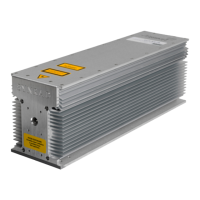getting started
8
SSYNRAD OEM v30 Operator’s Manual Version 2
Connecting
Coolants
SYNRAD recommends that the laser’s cooling uid contain at least 90% distilled water by volume. In
closed-loop systems, use a corrosion inhibitor/algaecide such as Optishield
®
Plus or equivalent as required.
Avoid glycol-based additives because they reduce the coolant’s heat capacity and high concentrations
may aect power stability. For SYNRAD lasers, the minimum coolant setpoint is 18 °C (64 °F) so glycol
is not necessary unless the chiller is subjected to freezing temperatures. If tap water is used, chloride levels
should not exceed a concentration of 25 parts per million (PPM). Install a lter on the chiller’s return line
and inspect frequently. Firestar OEM v30 lasers incorporate the following wetted materials in the coolant
path—nickel-plated brass, copper, acetal, PBT, polyethylene, stainless steel, and Viton
®
.
Note: DO NOT use de-ionized (DI) water as a coolant. DI water is unusually corrosive and is not rec-
ommended for mixed material cooling systems.
Setting coolant temperature
Choosing the correct coolant temperature is important to the proper operation and longevity of your laser.
When coolant temperature is lower than the dew point (the temperature at which moisture condenses out
of the surrounding air), condensation forms inside the laser housing leading to failure of laser electronics as
well as damage to optical surfaces.
The greatest risk of condensation damage occurs when the laser is in a high heat/high humidity environ-
ment and the chiller’s coolant temperature is colder than the dew point of the surrounding air or when the
system is shut down, but coolant continues to ow through the laser for extended periods of time.
The chiller’s temperature setpoint must always be set above the dew point temperature. In cases where this
is not possible within the specied coolant temperature range of 18 °C to 22 °C (64 °F to 72 °F), then the
following steps MUST be taken to reduce the risk of condensation damage.
■ Air-condition the room or the enclosure containing the laser.
■ Install a dehumidier to reduce the humidity of the enclosure containing the laser.
■ Stop coolant ow when the laser is shut down.
■ Increase coolant ow by an additional 3.8 lpm (1.0 GPM). Do not exceed a coolant pressure of 414
kPa (60 PSI).
Table 1-2 on the following page provides dew point temperatures for a range of air temperature and rela-
tive humidity values. Remember that the laser’s coolant temperature must be set above the dew point
temperatures shown in the chart; however, for best results and performance, do not exceed a coolant
temperature of 22 °C (72 °F).

